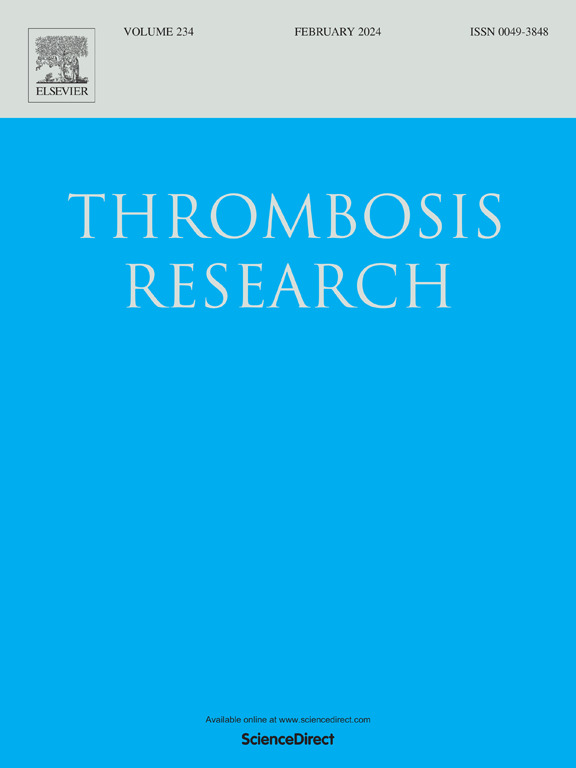华法林对抗磷脂综合征患者和护理点检测虚高INR患者的治疗控制
IF 3.4
3区 医学
Q1 HEMATOLOGY
引用次数: 0
摘要
血栓性抗磷脂综合征(APS)的标准治疗是使用维生素K拮抗剂(VKA)抗凝治疗。一些研究表明,狼疮抗凝剂(LA)可能会干扰通过即时检测(POCT)装置获得的国际标准化比率(INR)结果。一部分APS患者在POCT INR和医院实验室测量的血浆INR (P-INR)之间存在临床显著的系统性差异。目的:研究这些患者的POCT INR (CoaguChek,罗氏诊断)和P-INR之间的潜在相关性。材料和方法在我们的抗凝临床,我们比较了37例接受自我管理VKA的APS患者的363对CoaguChek-INR (CC-INR)和P-INR结果。每位患者至少有3次CC-INR和P-INR的成对测量,以及CC-INR/P-INR的中位数比值>;1.20.结果在所有患者中,我们发现CC-INR与P-INR之间存在很强的线性相关(中位R2: 0.89;差:0.78 - -0.94)。每个患者都有自己的特征回归线,CC-INR可由此转化为P-INR。34名患者继续自我管理治疗并使用转换表。然而,有3例患者在抗凝临床不得不切换到INR控制,因为他们的治疗CC-INR间隔的上限超过了CoaguChek设备上的最大值(INR: 8.0)。结论在一些APS患者中,在自我管理VKA治疗期间,POCT INR持续高于P-INR,大多数患者可以使用转换表继续自我管理治疗,因为错误升高的POCT INR值与P-INR呈线性相关。本文章由计算机程序翻译,如有差异,请以英文原文为准。
Control of warfarin treatment in patients with antiphospholipid syndrome and falsely high INR at point-of-care-testing
Background
The standard of care for thrombotic antiphospholipid syndrome (APS) is anticoagulation with vitamin K antagonists (VKA). Several studies have indicated that lupus anticoagulant (LA) can interfere with the international normalized ratio (INR) results obtained by point-of-care testing (POCT) devices. A subset of patients with APS has clinically significant systematic differences between POCT INR and plasma INR (P-INR) measured in the hospital laboratory.
Objectives
We aimed to investigate a potential correlation between POCT INR (CoaguChek, Roche Diagnostics) and P-INR in these patients.
Materials and methods
In our anticoagulation clinic, we compared 363 paired CoaguChek-INR (CC-INR) with P-INR results using Owren's method from 37 patients with APS receiving self-managed VKA. Each patient had a minimum of three paired measurements of CC-INR and P-INR and a median CC-INR/P-INR ratio > 1.20.
Results
In all patients, we found a strong linear correlation between CC-INR and P-INR (median R2: 0.89; IQR: 0.78–0.94). Each patient had their own characteristic regression line from which CC-INR could be converted to P-INR. Thirty-four patients continued with self-managed treatment and the use of a conversion table. However, 3 patients had to switch to INR control in the anticoagulation clinic, as the upper limit of their therapeutic CC-INR interval exceeded the maximum (INR: 8.0) on their CoaguChek device.
Conclusions
In a subset of patients with APS who, during self-managed VKA therapy, had persistently higher POCT INR than P-INR, the majority could continue with self-managed therapy using a conversion table, as the falsely elevated POCT INR values were linearly correlated to P-INR.
求助全文
通过发布文献求助,成功后即可免费获取论文全文。
去求助
来源期刊

Thrombosis research
医学-外周血管病
CiteScore
14.60
自引率
4.00%
发文量
364
审稿时长
31 days
期刊介绍:
Thrombosis Research is an international journal dedicated to the swift dissemination of new information on thrombosis, hemostasis, and vascular biology, aimed at advancing both science and clinical care. The journal publishes peer-reviewed original research, reviews, editorials, opinions, and critiques, covering both basic and clinical studies. Priority is given to research that promises novel approaches in the diagnosis, therapy, prognosis, and prevention of thrombotic and hemorrhagic diseases.
 求助内容:
求助内容: 应助结果提醒方式:
应助结果提醒方式:


